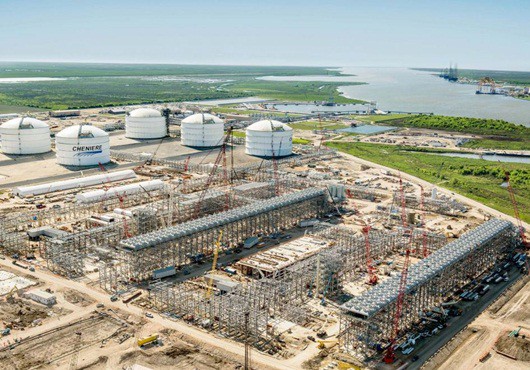 The liquefied natural gas market is growing every year, but the terminals that ship and receive the fuel are shrinking.
The liquefied natural gas market is growing every year, but the terminals that ship and receive the fuel are shrinking.
The booming sector’s next-generation infrastructure is being designed for a emerging-market buyers that want smaller volumes on shorter, more flexible contracts.
LNG export terminals, where the gas is liquefied and put on vessels for shipping, have traditionally been massive, custom-built facilities that cost tens of billions of dollars. And so to justify the investment, they have typically required equally massive, long-term supply deals, often lasting a decade or more.
Numerous terminal projects on the horizon, by contrast, are new modular-style designs built to snap together like Legos, allowing for small to mid-scale liquefaction or regasification plants that can be expanded if and when demand grows.
The first next-generation liquefaction plant is under construction in the U.S. state of Georgia and is expected to begin operating mid-year.
These facilities, with far smaller liquefaction units – known as trains – are “more consistent with market conditions,” said John Baguley, chief operating officer of Australia-based LNG Ltd , which has proposed mid-scale LNG plants in the United States and Canada.
The new designs reflect a maturing market with a more diverse base of customers that will drive future growth.
In 2008, the average contract was for 18 years and more than 2 million tonnes per annum (Mtpa). By 2016, it had dropped to less than eight years and less than 1 Mtpa, with new buyers in emerging markets like China, India and Pakistan seeking flexibility due to market uncertainty.
These new buyers are fueling small utilities and industrial users such as fertilizer plants and factories, said Alfred Moujaes, Houston President for Atlantic, Gulf and Pacific Company. The firm is building small, modular plants for LNG buyers, who need to convert the liquefied fuel back to a gas form after shipping.
Typically, such markets will be small at first, but the hope is that demand will grow as additional customers convert to LNG, Moujaes said. The modular plants allow terminals to grow with the market.
Demand for liquefied natural gas, or LNG, has taken off in recent years as it is a cleaner fuel than oil or coal, and abundant supply has driven its price sharply lower.
Overall global consumption of LNG rose to 33.1 billion cubic feet per day in 2016, about 10 percent of total natural gas usage; it is expected to grow by 75 percent by 2027, according to the U.S. Energy Information Administration.
The United States, with its abundant supply of pipeline gas and well-developed energy hubs such as the U.S. Gulf Coast, is emerging as a dominant global producer.
U.S. export capacity has shot up from less than 2 million tonnes per annum (Mtpa) in 2015 to 18 Mtpa in 2017, and is projected to top 77 Mtpa by 2022, transforming the United States into the world’s No. 2 exporter behind Australia.
In 2005, just 15 countries imported LNG; now there are 39, with another eight expected to hit the market by 2022, according to the International Energy Agency.
TINY TRAINS
The new style of North American liquefaction projects will be built in Asia before being shipped to the United States for assembly. At the heart of these new terminals are modular trains which produce just a fraction of the LNG of a traditional train.
LNG Ltd has proposed four 2-Mtpa trains at its Magnolia project in Louisiana, while Tellurian Inc is planning up to 20 1.38-Mtpa trains at its Driftwood project, also in Louisiana.
That compares to Cheniere Energy’s four 4.5-Mtpa trains now operating at its 18-Mtpa terminal in Sabine Pass.
With modular trains, companies hope to avoid the delays and cost overruns that have dogged custom mega-projects like Chevron Corp’s Wheatstone and Gorgon projects in Australia.
Another large terminal, Sempra Energy’s Cameron LNG project in Louisiana with three 4.5-Mtpa trains, has been delayed to 2019 after originally targeting a launch this year.
While modular designs allow more flexibility, some experts question whether they will ultimately cost less to build and be as easy to expand as promised, noting the technology is unproven.
“The issue that everybody is wrestling with is, does that really save you money?” said Jason Feer, head of business intelligence at shipbroker Poten and Partners.
The first such facility in the U.S. will provide a test case. The $2 billion Elba Island project, being built in Georgia’s Chatham County by Kinder Morgan , will have 10 trains and export capacity of just 2.5 Mtpa.
The technology is attractive enough that Cheniere has proposed a cluster of seven 1.36-Mtpa trains for a project being constructed in Corpus Christi, Texas, in addition to other, much larger liquefaction units.
Michael Wortley, Cheniere’s CFO, said in an interview that the company still believes traditional large-train designs work well. But it wanted to explore smaller-train technology, he said, to make sure “we weren’t missing anything.”
(Reporting by Julie Gordon; Editing by David Gaffen and Brian Thevenot)